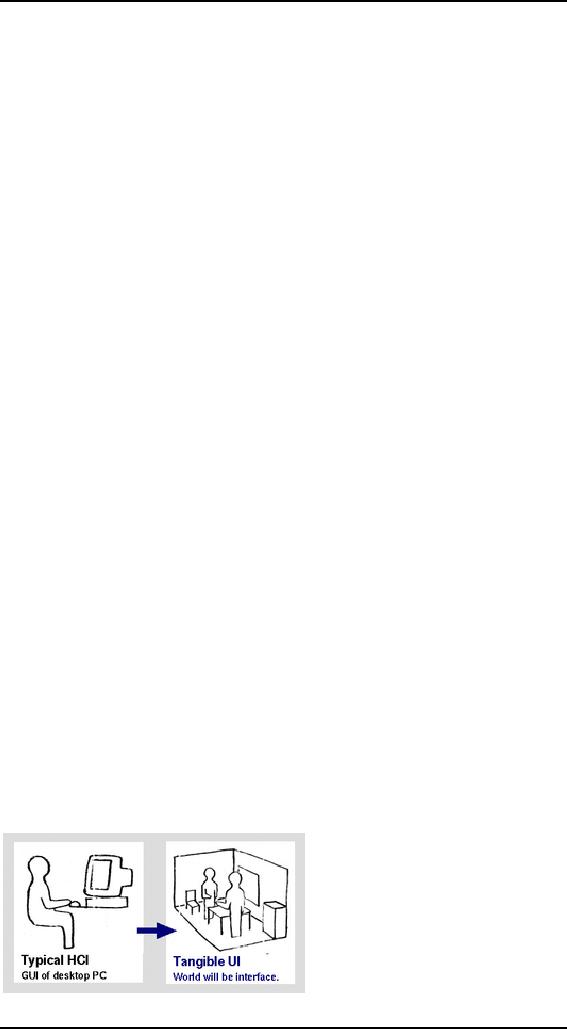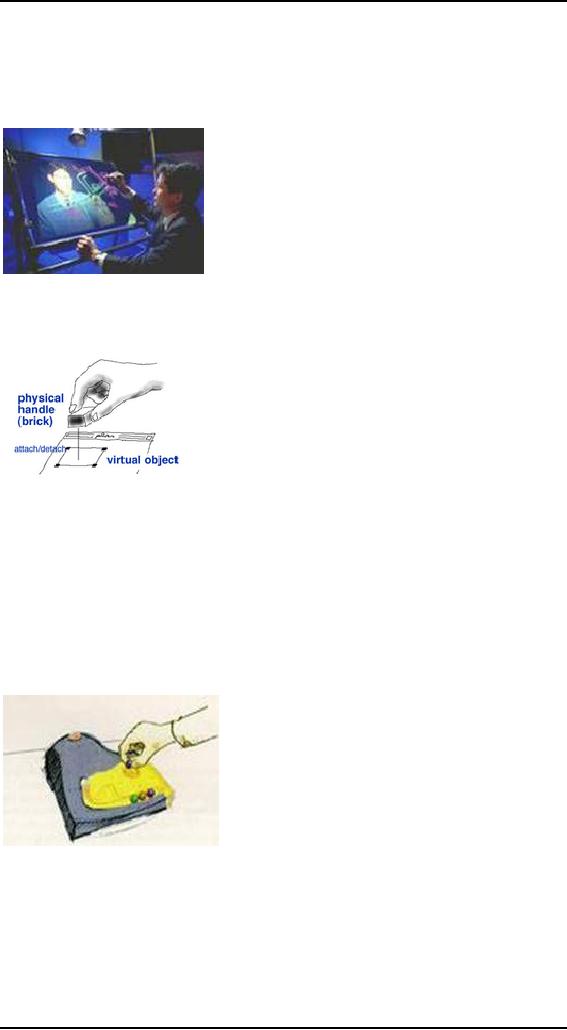 |
WEARABLE COMPUTING, TANGIBLE BITS, ATTENTIVE ENVIRONMENTS |
| << EMERGING PARADIGMS, ACCESSIBILITY |

Human
Computer Interaction
(CS408)
VU
Lecture
45
Lecture
45. Conclusion
Learning
Goals
As the
aim of this lecture is to
introduce you the study of
Human Computer
Interaction,
so that after studying this
you will be able to:
� Understand
the new and emerging
interaction paradigms
The most
common interaction paradigm in
use today is the desktop
computing
paradigm.
However, there are many
other different types of
interaction paradigms.
Some of
these are given below
and many are still
emerging:
Ubiquitous
computing
Ubiquitous
computing (ubicomp, or sometimes
ubiqcomp) integrates
computation
into
the environment, rather than
having computers which are
distinct objects.
Other
terms for
ubiquitous computing include
pervasive computing, calm
technology, and
things
that think. Promoters of this
idea hope that embedding
computation into the
environment
and everyday objects would
enable people to move around
and interact
with
information and computing
more naturally and casually
than they currently
do.
One of
the goals of ubiquitous
computing is to enable devices to
sense changes in
their
environment and to automatically
adapt and act based on these
changes based on
user
needs and preferences.
The
late Mark Weiser wrote
what are considered some of
the seminal papers in
Ubiquitous
Computing beginning in 1988 at
the Xerox Palo Alto
Research Center
(PARC).
Weiser was influenced in a
small way by the dystopian
Philip K. Dick novel
Ubik,
which envisioned a future in
which everything -- from
doorknobs to toilet-paper
holders,
were intelligent and
connected. Currently, the
art is not as mature as
Weiser
hoped,
but a considerable amount of
development is taking
place.
The MIT
Media Lab has also
carried on significant research in
this field, which
they
call
Things That Think.
American
writer Adam Greenfield
coined the term Everyware to
describe
technologies
of ubiquitous computing, pervasive
computing, ambient informatics
and
tangible
media. The article All
watched over by machines of loving
grace contains the
first
use of the term. Greenfield
also used the term as
the title of his book
Everyware:
The
Dawning Age of Ubiquitous
Computing (ISBN
0321384016).
Early
work in Ubiquitous Computing
The
initial incarnation of ubiquitous
computing was in the form of
"tabs", "pads", and
"boards"
built at Xerox PARC,
1988-1994. Several papers describe
this work, and
there
are web pages for
the Tabs and for the
Boards (which are a commercial
product
now):
Ubicomp
helped kick off the recent
boom in mobile computing
research, although it is
not
the same thing as mobile
computing, nor a superset
nor a subset.
437

Human
Computer Interaction
(CS408)
VU
Ubiquitous
Computing has roots in many
aspects of computing. In its
current form, it
was
first articulated by Mark
Weiser in 1988 at the
Computer Science Lab at
Xerox
PARC. He
describes it like
this:
Ubiquitous
Computing #1
Inspired
by the social scientists, philosophers,
and anthropologists at PARC, we
have
been
trying to take a radical
look at what computing and
networking ought to be
like.
We
believe that people live
through their practices and
tacit knowledge so that
the
most
powerful things are those
that are effectively
invisible in use. This is a
challenge
that
affects all of computer
science. Our preliminary
approach: Activate the
world.
Provide
hundreds of wireless computing
devices per person per
office, of all scales
(from 1"
displays to wall sized).
This has required new
work in operating
systems,
user
interfaces, networks, wireless,
displays, and many other
areas. We call our
work
"ubiquitous
computing". This is different
from PDA's, dynabooks, or
information at
your
fingertips. It is invisible, everywhere
computing that does not
live on a personal
device of
any sort, but is in the
woodwork everywhere.
Ubiquitous
Computing #2
For
thirty years most interface design,
and most computer design,
has been headed
down
the path of the "dramatic"
machine. Its highest ideal
is to make a computer so
exciting,
so wonderful, so interesting, that we
never want to be without it.
A less-
traveled
path I call the "invisible";
its highest ideal is to make
a computer so
imbedded,
so fitting, so natural, that we
use it without even thinking
about it. (I have
also
called this notion
"Ubiquitous Computing", and
have placed its origins in
post-
modernism.)
I believe that in the next
twenty years the second path
will come to
dominate.
But this will not be easy;
very little of our current
systems infrastructure
will
survive. We have been building
versions of the infrastructure-to-come at
PARC
for
the past four years, in the
form of inch-, foot-, and
yard-sized computers we call
Tabs,
Pads, and Boards. Our
prototypes have sometimes succeeded,
but more often
failed to
be invisible. From what we
have learned, we are now
explorting some new
directions
for ubicomp, including the
famous "dangling string"
display.
Wearable
Computing
45.1
Personal
Computers have never quite
lived up to their name. There is a
limitation to
the
interaction between a user
and a personal computer.
Wearable computers break
this
boundary. As the name suggests
these computers are worn on
the body like a
piece of
clothing. Wearable computers have been
applied to areas such as
behavioral
modeling,
health monitoring systems,
information technologies and
media
development.
Government organizations, military,
and health professionals
have all
incorporated
wearable computers into their
daily operations. Wearable computers
are
especially
useful for applications that
require computational support
while the user's
hands,
voice, eyes or attention are
actively engaged with the
physical environment.
Wristwatch
videoconferencing system running GNU
Linux, later featured in
Linux
Journal
and presented at ISSCC2000One of the
main features of a wearable
computer
is constancy.
There is a constant interaction between
the computer and user,
ie. there
is no need to
turn the device on or off.
Another feature is the
ability to multi-task. It is
not
necessary to stop what you
are doing to use the
device; it is augmented into
all
other
actions. These devices can
be incorporated by the user to act
like a prosthetic. It
can
therefore be an extension of the user's
mind and/or body.
438

Human
Computer Interaction
(CS408)
VU
Such
devices look far different
from the traditional cyborg
image of wearable
computers,
but in fact these devices
are becoming more powerful
and more wearable
all
the time. The most extensive
military program in the wearables arena
is the US
Army's
Land Warrior system, which will
eventually be merged into
the Future Force
Warrior
system.
Issues
Since
the beginning of time man
has fought man. The
difference between the
18th
century
and the 21st century
however, is that we are no
longer fighting with guns
but
instead
with information. One of the most
powerful devices in the past
few decades is
the
computer and the ability to
use the information
capabilities of such a device
have
transformed
it into a weapon.
Wearable
computers have led to an increase in
micro-management. That is, a
society
characterized
by total surveillance and a
greater influence of media
and technologies.
Surveillance
has impacted more personal
aspects of our daily lives
and has been used
to punish
civilians for seemingly
petty crimes. There is a
concern that this
increased
used of
cameras has affected more
personal and private moments in
our lives as a
form of
social control.
History
Depending
on how broadly one defines
both wearable and computer,
the first
wearable
computer could be as early as
the 1500s with the invention
of the pocket
watch or
even the 1200s with
the invention of eyeglasses.
The first device that
would
fit the
modern-day image of a wearable
computer was constructed in
1961 by the
mathematician
Edward O. Thorp, better
known as the inventor of the
theory of card-
counting
for blackjack, and Claude E.
Shannon, who is best known
as "the father of
information
theory." The system was a
concealed cigarette-pack sized
analog
computer
designed to predict roulette
wheels. A data-taker would
use microswitches
hidden in
his shoes to indicate the
speed of the roulette wheel,
and the computer
would
indicate an octant to bet on by
sending musical tones via
radio to a miniature
speaker
hidden in a collaborators ear
canal. The system was
successfully tested in Las
Vegas in
June 1961, but hardware
issues with the speaker
wires prevented them
from
using it
beyond their test runs.
Their wearable was kept
secret until it was
first
mentioned
in Thorp's book Beat the
Dealer (revised ed.) in 1966
and later published
in detail
in 1969. The 1970s saw
rise to similar roulette-prediction
wearable
computers
using next-generation technology, in
particular a group known
as
Eudaemonic
Enterprises that used a CMOS
6502 microprocessor with 5K RAM
to
create a
shoe-computer with inductive
radio communications between a
data-taker
and
better (Bass 1985).
In 1967,
Hubert Upton developed an
analogue wearable computer
that included an
eyeglass-mounted
display to aid lip reading.
Using high and low-pass
filters, the
system
would determine if a spoken
phoneme was a fricative, stop
consonant, voiced-
fricative,
voiced stop consonant, or simply
voiced. An LED mounted on
ordinary
eyeglasses
illuminated to indicate the
phoneme type. The 1980s
saw the rise of more
general-purpose
wearable computers. In 1981
Steve Mann designed and
built a
backpack-mounted
6502-based computer to control
flash-bulbs, cameras and
other
photographic
systems. Mann went on to be an
early and active researcher
in the
wearables
field, especially known for
his 1994 creation of the
Wearable Wireless
Webcam
(Mann 1997). In 1989
Reflection Technology marketed
the Private Eye
439

Human
Computer Interaction
(CS408)
VU
head-mounted
display, which scanned a
vertical array of LEDs
across the visual
field
using a
vibrating mirror. 1993 also
saw Columbia University's
augmented-reality
system
known as KARMA: Knowledge-based Augmented
Reality for
Maintenance
Assistance.
Users would wear a Private
Eye display over one
eye, giving an
overlay
effect
when the real world
was viewed with both
eyes open. KARMA would
overlay
wireframe
schematics and maintenance
instructions on top of whatever
was being
repaired.
For example, graphical
wireframes on top of a laser printer
would explain
how to
change the paper tray. The
system used sensors attached
to objects in the
physical
world to determine their
locations, and the entire
system ran tethered from
a
desktop
computer (Feiner
1993).
The
commercialization of general-purpose
wearable computers, as led by
companies
such as
Xybernaut, CDI and ViA Inc,
has thus far met
with limited success.
Publicly-
traded
Xybernaut tried forging
alliances with companies such as IBM
and Sony in
order to
make wearable computing
widely available, but in
2005 their stock
was
delisted
and the company filed
for Chapter 11 bankruptcy
protection amid
financial
scandal
and federal investigation. In
1998 Seiko marketed the
Ruputer, a computer in
a (fairly
large) wristwatch, to mediocre
returns. In 2001 IBM developed
and publicly
displayed
two prototypes for a
wristwatch computer running
Linux, but the
product
never
came to market. In 2002
Fossil, Inc. announced the
Fossil WristPDA, which
ran
the
Palm OS. Its release date
was set for summer of 2003,
but was delayed
several
times
and was finally made
available on January 5,
2005.
Tangible
Bits
45.2
The
development from desktop to
physical environment can be
divided into two
phases:
the first one was
introduced by the Xerox Star
workstation in 1981.
This
workstation
was the first generation of
a graphical user interface
that sets up a
"desktop
metaphor". It simulates a real
physical desktop on a computer
screen with a
mouse,
windows and icons. The
Xerox Star workstation also
establishes some
important
HCI design principles like
"seeing and
pointing".
Ten years
later, in 1991, Marc Weiser
illustrates a different paradigm of
computing,
called
"ubiquitous computing". His
vision contains the
displacement of computers
into
the background and the
attempt to make them
invisible.
A new
paradigm desires to start the
next period of computing by
establish a new type
of HCI
called "Tangible User
Interfaces" (TUIs). Herewith
they try to make
computing
truly ubiquitous and
invisible. TUIs will change the
world itself to an
interface
(see figure below) with
the intention that all
surfaces (walls,
ceilings,
doors...)
and objects in the room will
be an interface between the
user and his
environment.
440

Human
Computer Interaction
(CS408)
VU
Below
are some examples:
The
ClearBoard (TMG, 1990-95)
has the idea of changing a
passive wall to an active
dynamic
collaboration medium. This leads to
the vision, that all
surfaces become
active
surfaces through which
people can interact with
other (real and virtual)
spaces
(see
figure below).
Bricks
(TMG, 1990-95) is a graphical
user interface that allows
direct control of
virtual
objects through handles
called "Bricks". These
Bricks can be attached
to
virtual
objects and thus make
them graspable. This project
encouraged two-handed
direct
manipulation of physical objects
(see figure below).
The
Marble Answering Machine (by
Durell Bishop, student at
the Royal College of
Art) is a
prototype telephone answering
machine. Incoming voice
messages are
represented by
marbles, the user can
grasp and then drop to
play the message or
dial
the
caller automatically. It shows
that computing doesn't have
to take place at a desk,
but it
can be integrated into
everyday objects. The Marble
Answering Machine
demonstrates
the great potential of
making digital information graspable
(see figure
below).
Goals
and Concepts of "tangible
bits"
In our
world there exist two
realms: the physical
environment of atoms and
the
cyberspace of
bits. Interactions between
these two spheres are
mostly restricted to
GUI-
based boxes and as a result
separated from ordinary
physical environments. All
senses,
work practices and skills
for processing information we have
developed in the
past are
often neglected by our
current HCI designs.
Goals
441

Human
Computer Interaction
(CS408)
VU
So there
is a need to augment the real
physical world by coupling
digital information
to
everyday things. In this
way, they bring the
two worlds, cyberspace and
real world,
together
by making digital information
tangible. All states of physical
matter, that
means,
not only solid matter,
but also liquids and
gases become interfaces
between
people
and cyberspace. It intends to allow
users both to "grasp and
manipulate"
foreground
bits and be aware of
background bits. They also
don't want to have a
distinction
between special input and
output devices any longer,
e.g. between
representation
and control. Nowadays,
interaction devices are divided
into input
devices
like mice or keyboards and
output devices like screens.
Another goal is not
to
have a
one-to-one mapping between
physical objects and digital
information, but an
aggregation
of several digital information
instead.
Concepts
To
achieve these goals, they
worked out three key
concepts: "interactive surfaces",
"coupling
bits and atoms" and
"ambient media". The concept
"interactive surfaces"
suggests
a transformation of each surface (walls,
ceilings, doors, desktops)
into an
active
interface between physical
and virtual world. The
concept "coupling bits
and
atoms"
stands for the seamless
coupling of everyday objects
(card, books, and
toys)
with
digital information. The
concept "ambient media"
implies the use of sound,
light,
air
flow, water movement for
background interfaces at the
periphery of human
perception.
45.3
Attentive
Environments
Attentive
environments are environments
that are user and
context aware. One
project
which
explores these themes is
IBM's BlueEyes research
project is chartered to
explore
and define attentive
environments.
Animal
survival depends on highly developed
sensory abilities. Likewise,
human
cognition
depends on highly developed abilities to
perceive, integrate, and
interpret
visual,
auditory, and touch
information. Without a doubt, computers
would be much
more
powerful if they had even a
small fraction of the
perceptual ability of animals
or
humans.
Adding such perceptual
abilities to computers would enable
computers and
humans to
work together more as
partners. Toward this end,
the BlueEyes project
aims at
creating computational devices
with the sort of perceptual
abilities that people
take
for granted.
How
can we make computers "see"
and "feel"?
BlueEyes
uses sensing technology to identify a
user's actions and to
extract key
information.
This information is then
analyzed to determine the
user's physical,
emotional,
or informational state, which in
turn can be used to help
make the user
more
productive by performing expected
actions or by providing
expected
information.
For example, a BlueEyes-enabled
television could become active
when
the
user makes eye contact, at
which point the user
could then tell the
television to
"turn
on".
In the
future, ordinary household
devices -- such as televisions,
refrigerators, and
ovens --
may be able to do their jobs
when we look at them and
speak to them.
442
Table of Contents:
- RIDDLES FOR THE INFORMATION AGE, ROLE OF HCI
- DEFINITION OF HCI, REASONS OF NON-BRIGHT ASPECTS, SOFTWARE APARTHEID
- AN INDUSTRY IN DENIAL, SUCCESS CRITERIA IN THE NEW ECONOMY
- GOALS & EVOLUTION OF HUMAN COMPUTER INTERACTION
- DISCIPLINE OF HUMAN COMPUTER INTERACTION
- COGNITIVE FRAMEWORKS: MODES OF COGNITION, HUMAN PROCESSOR MODEL, GOMS
- HUMAN INPUT-OUTPUT CHANNELS, VISUAL PERCEPTION
- COLOR THEORY, STEREOPSIS, READING, HEARING, TOUCH, MOVEMENT
- COGNITIVE PROCESS: ATTENTION, MEMORY, REVISED MEMORY MODEL
- COGNITIVE PROCESSES: LEARNING, READING, SPEAKING, LISTENING, PROBLEM SOLVING, PLANNING, REASONING, DECISION-MAKING
- THE PSYCHOLOGY OF ACTIONS: MENTAL MODEL, ERRORS
- DESIGN PRINCIPLES:
- THE COMPUTER: INPUT DEVICES, TEXT ENTRY DEVICES, POSITIONING, POINTING AND DRAWING
- INTERACTION: THE TERMS OF INTERACTION, DONALD NORMAN’S MODEL
- INTERACTION PARADIGMS: THE WIMP INTERFACES, INTERACTION PARADIGMS
- HCI PROCESS AND MODELS
- HCI PROCESS AND METHODOLOGIES: LIFECYCLE MODELS IN HCI
- GOAL-DIRECTED DESIGN METHODOLOGIES: A PROCESS OVERVIEW, TYPES OF USERS
- USER RESEARCH: TYPES OF QUALITATIVE RESEARCH, ETHNOGRAPHIC INTERVIEWS
- USER-CENTERED APPROACH, ETHNOGRAPHY FRAMEWORK
- USER RESEARCH IN DEPTH
- USER MODELING: PERSONAS, GOALS, CONSTRUCTING PERSONAS
- REQUIREMENTS: NARRATIVE AS A DESIGN TOOL, ENVISIONING SOLUTIONS WITH PERSONA-BASED DESIGN
- FRAMEWORK AND REFINEMENTS: DEFINING THE INTERACTION FRAMEWORK, PROTOTYPING
- DESIGN SYNTHESIS: INTERACTION DESIGN PRINCIPLES, PATTERNS, IMPERATIVES
- BEHAVIOR & FORM: SOFTWARE POSTURE, POSTURES FOR THE DESKTOP
- POSTURES FOR THE WEB, WEB PORTALS, POSTURES FOR OTHER PLATFORMS, FLOW AND TRANSPARENCY, ORCHESTRATION
- BEHAVIOR & FORM: ELIMINATING EXCISE, NAVIGATION AND INFLECTION
- EVALUATION PARADIGMS AND TECHNIQUES
- DECIDE: A FRAMEWORK TO GUIDE EVALUATION
- EVALUATION
- EVALUATION: SCENE FROM A MALL, WEB NAVIGATION
- EVALUATION: TRY THE TRUNK TEST
- EVALUATION – PART VI
- THE RELATIONSHIP BETWEEN EVALUATION AND USABILITY
- BEHAVIOR & FORM: UNDERSTANDING UNDO, TYPES AND VARIANTS, INCREMENTAL AND PROCEDURAL ACTIONS
- UNIFIED DOCUMENT MANAGEMENT, CREATING A MILESTONE COPY OF THE DOCUMENT
- DESIGNING LOOK AND FEEL, PRINCIPLES OF VISUAL INTERFACE DESIGN
- PRINCIPLES OF VISUAL INFORMATION DESIGN, USE OF TEXT AND COLOR IN VISUAL INTERFACES
- OBSERVING USER: WHAT AND WHEN HOW TO OBSERVE, DATA COLLECTION
- ASKING USERS: INTERVIEWS, QUESTIONNAIRES, WALKTHROUGHS
- COMMUNICATING USERS: ELIMINATING ERRORS, POSITIVE FEEDBACK, NOTIFYING AND CONFIRMING
- INFORMATION RETRIEVAL: AUDIBLE FEEDBACK, OTHER COMMUNICATION WITH USERS, IMPROVING DATA RETRIEVAL
- EMERGING PARADIGMS, ACCESSIBILITY
- WEARABLE COMPUTING, TANGIBLE BITS, ATTENTIVE ENVIRONMENTS